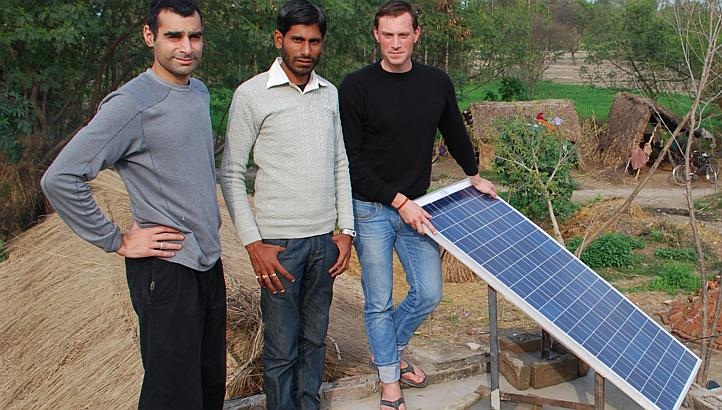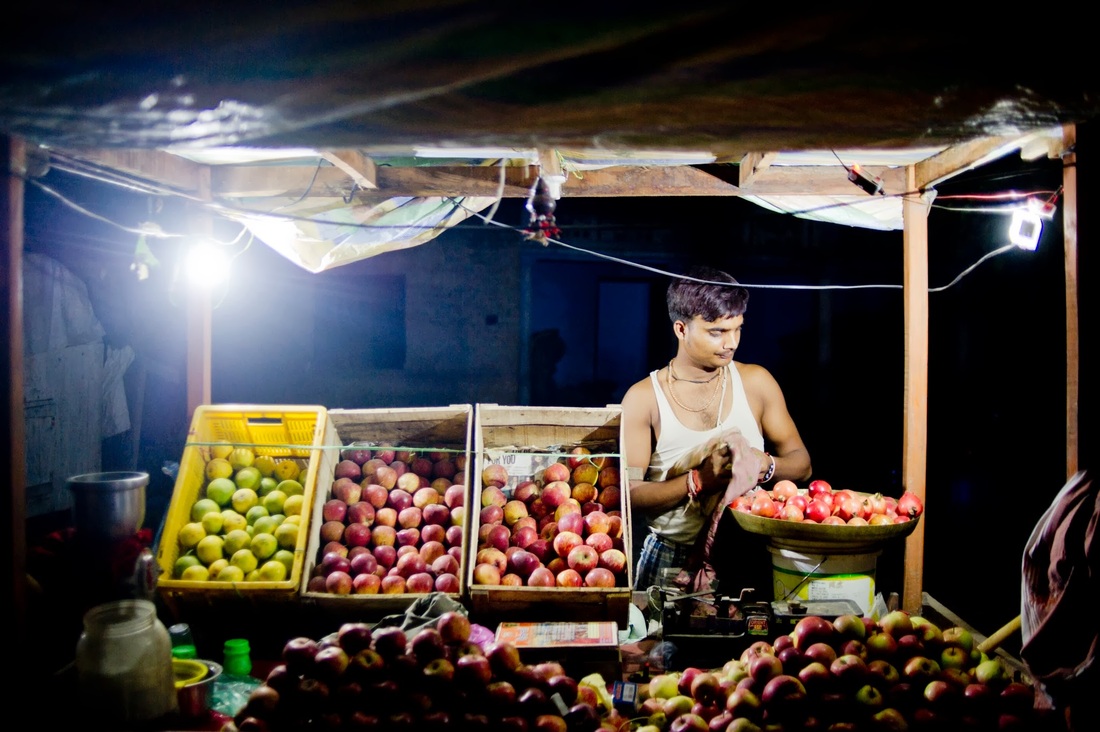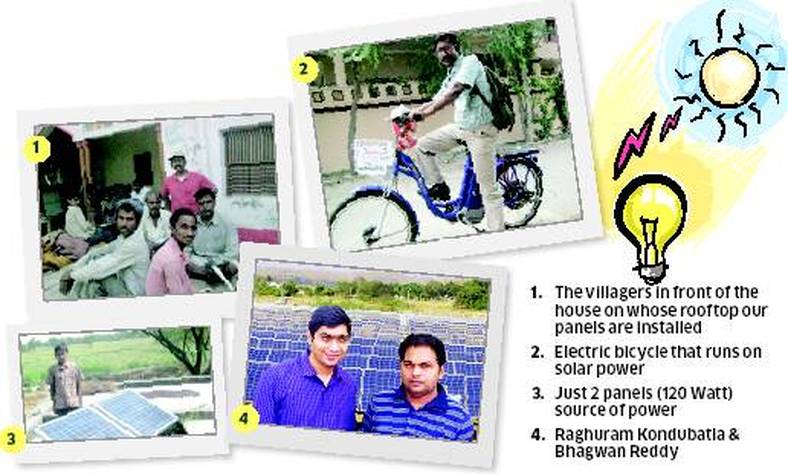Solar Micro Grid - Big Business in small groups
Amidst scores of un-electrified villages in Uttar Pradesh, Ram Sahu, a farmer in Thigra village, relishes his dinner beside a solar powered electric fan and LED lamp. Miles away in a village near Agra, lit up only by kerosene lamps, another farmer enjoys benefits from solar appliances which source power through a microgrid- a small standalone system connected to solar panels which can supply power to about 100 households.
And by the looks of it, every village in India will soon be electrified, thanks to a solar microgrid revolution heating up.
And by the looks of it, every village in India will soon be electrified, thanks to a solar microgrid revolution heating up.
Nikhil Jaisinghani & Brian Shaad, a Foreign Service officer of USAID and an international development practitioner comes together for a venture in renewable energy may be no big deal, except if you happen to live in villages in and around the Sitapur district in UP. Thanks to Mera Gaon Power (MGP), started by Nikhil & Brian, they now get seven hours of electricity per night at just Rs 25 per week.
The two US citizens while working in Nigeria on captured flare gas had noticed that equipments and facilities reached the farmers but utilizing it was out of their capacity. When Nikhil moved to India in 2009, he witnessed the same problem existed for solar generated power energy in India. MGP's village-level lighting facility generates electricity through centrally located solar panels and stores the generated electricity in batteries.
Power is distributed over a short distance from the battery bank to households within the village for seven hours per night. Every household gets light through light emitting diodes (LEDs), which reduce power consumption by 90% per household. Each household can get its set-up of two or four LED and a mobile charging point at a one-time price of Rs 40.
The two US citizens while working in Nigeria on captured flare gas had noticed that equipments and facilities reached the farmers but utilizing it was out of their capacity. When Nikhil moved to India in 2009, he witnessed the same problem existed for solar generated power energy in India. MGP's village-level lighting facility generates electricity through centrally located solar panels and stores the generated electricity in batteries.
Power is distributed over a short distance from the battery bank to households within the village for seven hours per night. Every household gets light through light emitting diodes (LEDs), which reduce power consumption by 90% per household. Each household can get its set-up of two or four LED and a mobile charging point at a one-time price of Rs 40.
In this model, a customer registers with the microgrid owner with a monthly subscription, and the service provider provides him solar power for two lights, a fan and cell phone charging socket.
A microgrid costs under Rs 60,000 to set up and the project costs get recovered in three years -- including maintenance, upgrades and other overheads. Households save money each month which helps ensure payments. These micro-economics are sound, low-risk and sustainable and are attractive for investors," says Sameer Halai, co-founder of SunFunder, a crowdfunding platform which gets investors to invest in microgrid projects. SunFunder has just raised funds from Vinod Khosla, testimony to microgrid market's potential.
A microgrid costs under Rs 60,000 to set up and the project costs get recovered in three years -- including maintenance, upgrades and other overheads. Households save money each month which helps ensure payments. These micro-economics are sound, low-risk and sustainable and are attractive for investors," says Sameer Halai, co-founder of SunFunder, a crowdfunding platform which gets investors to invest in microgrid projects. SunFunder has just raised funds from Vinod Khosla, testimony to microgrid market's potential.
"A customer would spend Rs 160 a month for his mobile charging and kerosene for lamps. We charge him Rs 100," says Brian Shaad, co-founder of Mera Gao Power, a microgrid firm. It is cheaper than kerosene and has been growing rapidly, adding about 2,000 subscribers a month, he says.
With such clear economics, more companies are looking at the sector. "People in the industry clearly see the business opportunity here now as there are hundreds of villages with no electricity and it doesn't make economic sense for the government to put up a grid" Shaad said.
While Mera Gao Power has electrified about 20,000 households, another firm, Minda NextGenTech, has put up 250 microgrid systems. Minda operates on a slightly different model where it doesn't own the system but sells them to an entrepreneur and helps with funding.
While Mera Gao Power has electrified about 20,000 households, another firm, Minda NextGenTech, has put up 250 microgrid systems. Minda operates on a slightly different model where it doesn't own the system but sells them to an entrepreneur and helps with funding.
Mera Gao Power plans to add about 2000 more subscribers every month, while Minda is targeting another 200 villages. Mera Gao Micro Grid Power is a “micro-lighting utility” , installing local grid systems in Uttar Pradesh, an Indian region close to the Nepalese border.
SunEdison, which put up a project in Madhya Pradesh, is working on projects in Andhra Pradesh and Madhya Pradesh, while Welspun Renewables, for instance, will soon commission its first microgrid project in Uttar Pradesh.
"Solar micro-grids help supply electricity and have potential to create jobs," says Vineet Mittal of Welspun Renewables.
SunEdison, which put up a project in Madhya Pradesh, is working on projects in Andhra Pradesh and Madhya Pradesh, while Welspun Renewables, for instance, will soon commission its first microgrid project in Uttar Pradesh.
"Solar micro-grids help supply electricity and have potential to create jobs," says Vineet Mittal of Welspun Renewables.
The MGP system simply consists of:
- four solar panels, enough to power 100 households, which are mounted onto a household,
- a battery bank to provide 2-days worth of electricity,
- a low-voltage power distribution network,
- LED lamps for households.
Mera Gao MGP is a for-profit social enterprise, striving for a 15% minimum return on investment (ROI) for investors. With MGP’s model, returns start coming in after about a year and half, making it a win-win situation for all.
Since last summer, Mera Gao has installed systems in 9 villages and hopes to reach another 70 villages (providing electricity for 3,000 customers) by the end of this year!
The microgrid is undoubtedly a promising solution for communities lacking basic energy needs – but as the Rocky Mountain Institute perscribes, could the microgrid also be the necessary foundation for a more intelligent, electrified, efficient energy system of the future for us all?
Since last summer, Mera Gao has installed systems in 9 villages and hopes to reach another 70 villages (providing electricity for 3,000 customers) by the end of this year!
The microgrid is undoubtedly a promising solution for communities lacking basic energy needs – but as the Rocky Mountain Institute perscribes, could the microgrid also be the necessary foundation for a more intelligent, electrified, efficient energy system of the future for us all?
However, there are still some snags to be ironed out. "The main barrier to their success is access to financing to help scale their operations. It's difficult to bring high volume foreign funds for business lending into India. This is a challenge we are working to solve actively," Halai said.
Firms say that while for the immediate term, lending from NABARD would help, to take this on a longer term, government support would be required in terms of giving service providers protection and status to function like a state electricity utility.
Firms say that while for the immediate term, lending from NABARD would help, to take this on a longer term, government support would be required in terms of giving service providers protection and status to function like a state electricity utility.




